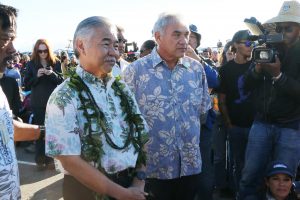Finding a way forward on Mauna Kea, TMT
Posted on Aug 29, 2019 in Capitol Connection, FeaturedFew issues in recent memory have been more controversial for Hawai‘i than the Thirty Meter Telescope (TMT) project. As people weigh in on all sides, Governor Ige continues to believe that respect for Mauna Kea can be reconciled with astronomy and that Native Hawaiian culture and modern science can work together to benefit the whole community. This edition provides more perspectives on the TMT project and efforts like the ‘Imiloa Astronomy Center, which is setting an example for the future.

Governor Ige and William Aila,Jr. director of the Department of Hawaiian Home Lands, went to Mauna Kea to meet with those protesting the TMT project. | COURTESY DLNR
Q. What do you see as the way forward to resolve this issue peacefully?
A. From the most recent polls, we know the majority of people in the islands support the Thirty Meter Telescope project for the benefits it can provide the state and the world. After 10 years of legal review and thousands of pages of documents and testimony from all sides, it has been determined the project has the right to proceed, and as governor I’m obligated to enforce the law. It’s important to know that TMT planners listened to community, cultural and environmental concerns and made changes where needed. This included relocating the telescope from the summit ridge and contributing to conservation of the area as well as STEM education. As the leader of this state, I want to work with protest leaders and others to come to a reasonable resolution that ensures safety and respects the law. We can achieve a better future for everyone when we work together.
Q. What concerns you most about the current controversy?
A. If the activists say there’s no compromise, then it leaves the state with few options. We will enforce the law while making people aware of the facts that have been part of this decade-long legal process. A lot of misinformation is being circulated so we want to provide factual, accurate details so people can base their opinions on sound information rather than rumors. We encourage everyone’s patience as we work to find a peaceful way forward that respects community concerns and deeply held feelings.
Q. Your 10-point plan from 2015 proposed major improvements for Mauna Kea stewardship. Why did you feel that was needed?
A. I thought the state needed to do a better job of managing the entire summit. Most of the elements of the plan are in motion and several are reflected in the findings affirmed by the Hawai‘i Supreme Court. Included in the report approved by the Board of Land and Natural Resources are 43 special conditions related to the environment, education, cultural practices and jobs for the TMT to be implemented. The university has been listening to concerns and has committed to taking down several existing telescopes. The fact is, even with the TMT, there will be less development on Mauna Kea than currently exists.
Q. Mayor Harry Kim has said, “For us to go forward, we have to understand the whole issue of discontent, dating back to 1893” (when Queen Lili‘uokalani abdicated the throne). Would you agree?
A. Yes, and I would be the first to say that we have much more work to do to right the wrongs of the past. But we shouldn’t discount the progress we’ve made as a community — decisive, corrective action to improve the lives of Native Hawaiians — ranging from the public Hawaiian immersion programs to the creation of the Office of Hawaiian Affairs and record-high funding for the Department of Hawaiian Home Lands. One of the protest leaders noted that I worked with Governor Waihee to establish the first Hawaiian immersion programs on O‘ahu and Hawai‘i island in 1987. It was clear to me then that saving the language was fundamental to saving the culture. I thought if our citizens could be fluent in Hawaiian and English, that would be the best of all worlds. Yes, some of those citizens are on the mauna now, but I still believe we can support both the Hawaiian culture and projects like the TMT.